Tobi Maier: João, I was wondering if you could begin by telling us about the exhibition and introducing the title Eternally Collapsing Objects.
João Ferro Martins: Well, I wanted to say a few things first, so that you understand… Because I’m going to talk about many different subjects, which are juxtaposed in my working process. The different galleries are not only about one subject nor do any of the gallery spaces deal with one subject alone. There is normally, almost always, an overlap, a set of ideas, some political, some social, some economic, some artistic… There are many layers and the exhibition title also reflects this to a certain degree. This title – Eternally Collapsing Objects – comes from a term, namely “eternally collapsing object”, which is a theory that is no longer in use, hence it failed […]. It was a theory about black holes, which ultimately fell apart. Meanwhile, there are new theories, but this was the name of one of them. Parts of that theory are still used in new theories but, as a whole, the theory no longer exists, and I’m also interested in that non-utility, a bit like these objects here, which are also, in a way, no longer useful. And this is something I work on a lot, the loss of usefulness or reshaping the usefulness of a certain object.
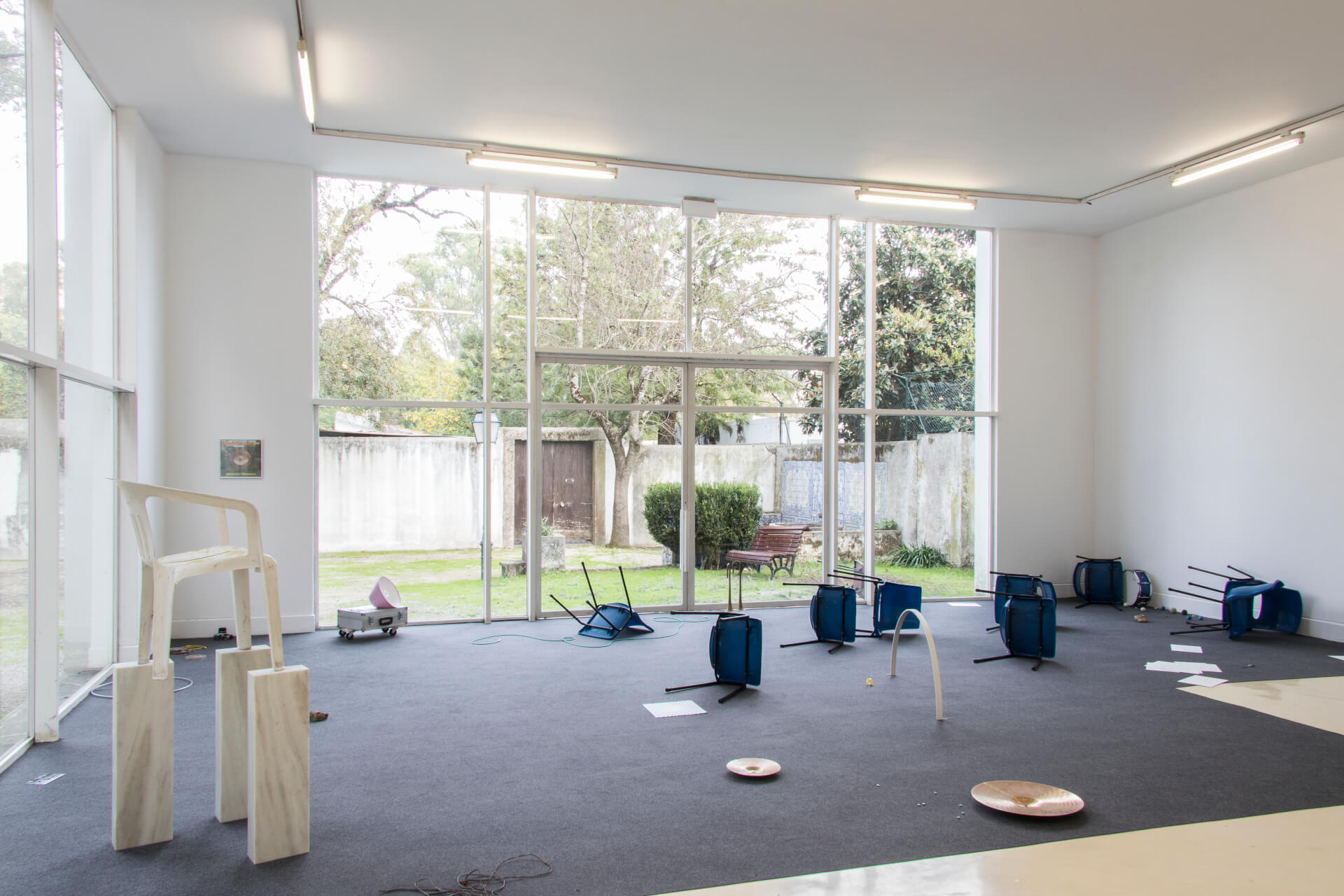
João Ferro Martins; Studio Eloise; Site-specific installation; 2020. © João Ferro Martins
So, I was very interested in this expression “eternally collapsing object” because the acronym, ECO, could also refer to an environmental theme. And that environmental theme was precisely one of the layers in the first room down there on the left. When we enter, there is an evocation, for me a double one, that can refer both to a devastated area (after a storm or hurricane) and a space that has been left in a hurry, abandoned. And, in this case, it interested me that this whole exhibition, once again reinforcing the line of my work, […] talked about music and about sound, that it discussed them – not necessarily that it was a sound exhibition, but, once again, an exhibition on music. And there the evocations are many. Obviously, I don’t want to narrow down the reading, but it can range from the office or the company that went bankrupt, to the sound studio that stopped producing and closed…
I used this environment of destruction, of abandonment, to install some works that are more evidently on display and still standing. Basically, it works as a complete installation, and then it is punctuated by small sculptural events, and it is there that my plastic work is more visible. There are parts that you can almost remove from the puzzle and form individual works but, in this case, I was more interested in making a complete installation. And the title of the room, which specifically recalls this climate theme, is Studio Eloise. “Eloise” was the name given to a storm. I’d been doing some research (not particularly extensive, but research nevertheless) into how storms began to be named. And I ended up choosing the name of a storm from 1975, which was the most powerful storm in the United States that year, off the coast of Florida, and it was named “Eloise”. In 1975, why? I went with this year because, in the second room, there’s a replica of an object, an analogue synthesiser, which was invented in the 1960s and has undergone a series of developments. And the replica I made is of a version of this object – which is the Moog System 55 – from precisely 1975, the same year as that storm.
Just to finish up with this first gallery space: it’s a space where you can very clearly see my most typical formal games, my most rigid, rhetorical mental structure and yet also some traces of a sense of humour, a humour that’s very particular to my work. So, it allows you to have that almost total immersion. As an installation, it’s a piece that has a lot to do with my way of exhibiting, which is usually more about filling and less about emptying. But then I also tried, here in the Pavilhão Branco, to do the opposite, which was precisely to create counterpoints between noise and then simpler, emptier, more purified rooms.
That brings us to gallery number two, the second one downstairs, which, returning to the title again, Eternally Collapsing Objects, has a metaphorical representation of what could be a black hole, that black glass that I called Trapped Surface – “trapped surface” is the name given to the inside of a black hole, it’s the capture surface. Everything that’s absorbed enters that circle. Complementing this, the exhibition publication will be an LP, a music record made by me. I’ll talk more about that later, but very briefly, suffice to say that one of the themes directly relates to this glass. It’s called Infinite Density, which is basically what happens to an object when it enters this trapped surface: according to this theory, its mass changes and it attains infinite mass, so it acquires infinite density.
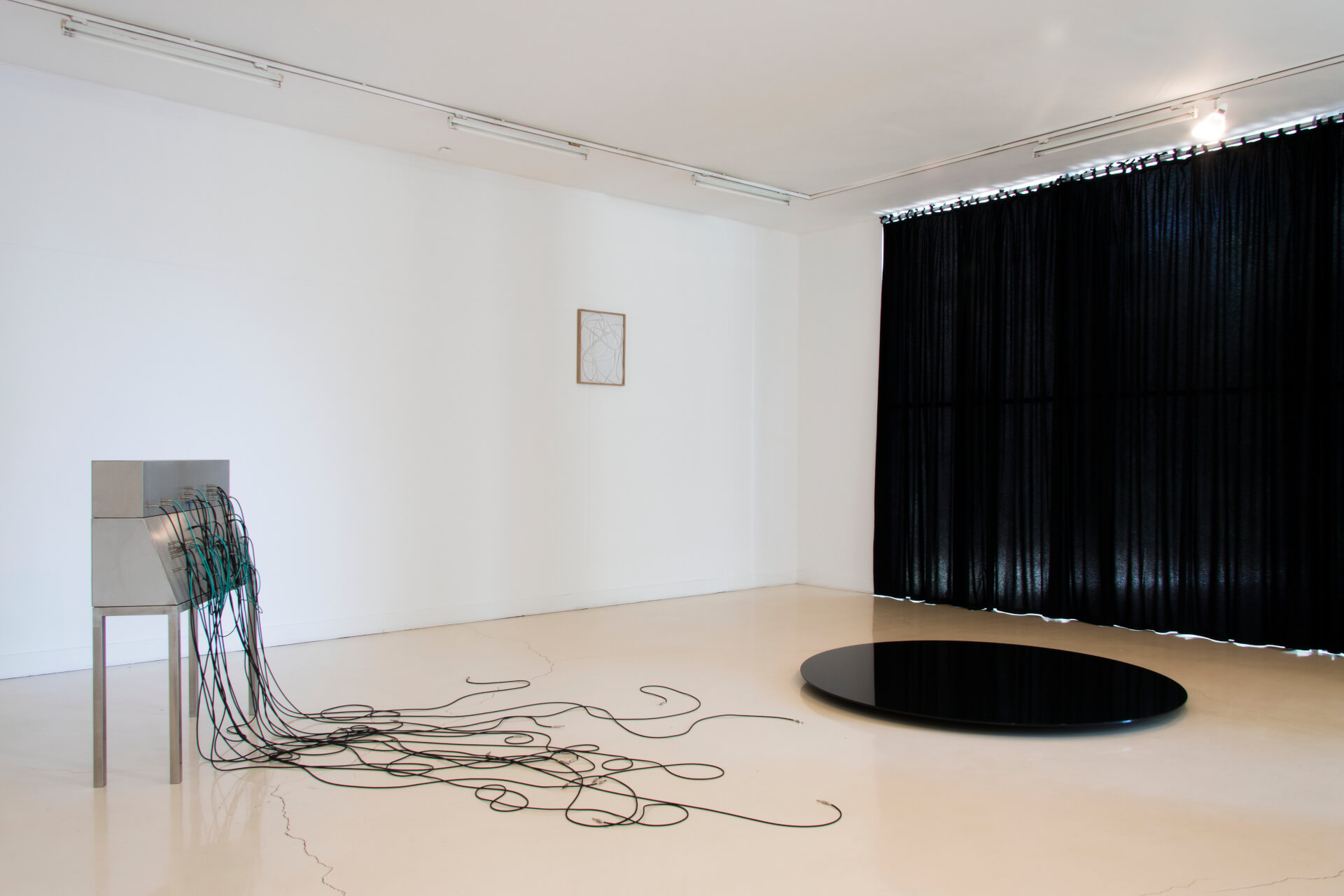
João Ferro Martins; Moog System 55; Stainless steel, cables and audio plugs; 2020 | Untitled; Polyester ribbon and frame; 2020 | Trapped Surface; Enamel on glass; 2020. © João Ferro Martins
I’m playing here with the various phases of the “black hole” itself. Next to it, we have this object which is a replica of an analogue synthesiser. Moog is an American brand, and this object is used to make music. It generates sound waves and then, by connecting and disconnecting cables, that sound wave is altered and creates textures and rhythms. These types of objects were widely explored in the late 1960s and 1970s. These Moogs became very famous with the sound exploration work done in England by the BBC at that time. So, it’s funny that the object is American but it’s in Europe that it’s widely used, initially by progressive rock music groups and in a lot of radio advertising and then subsequently on television: on the BBC, for example, where they started using this object because it acted like an orchestra to a certain extent. And since it was extremely expensive to hire orchestras all the time to make the advertisements etc., they started using electronic music because it was very cheap to make jingles for radio and television that way. But then there was a whole underworld of experimentalism with these machines. So, between jingle and experimentation, these artists who were paid to make commercial music then had time to experiment and make avant-garde music in their spare time using studio equipment.
There’s one more object [Untitled, 2020] in that room, which is a kind of three-dimensional doodle – it’s a drawing exercise that was chosen to formally balance the room. There’s a communication between the gesture of this drawing and the arrangement of the audio cables in the other work. Obviously, it’s not a drawing, it’s a framed plastic ribbon, a polyester strip compressed inside a frame, but it has a certain drawing quality that interests me and that can also be related to the drawing quality which the cables have when they come out of the machine.
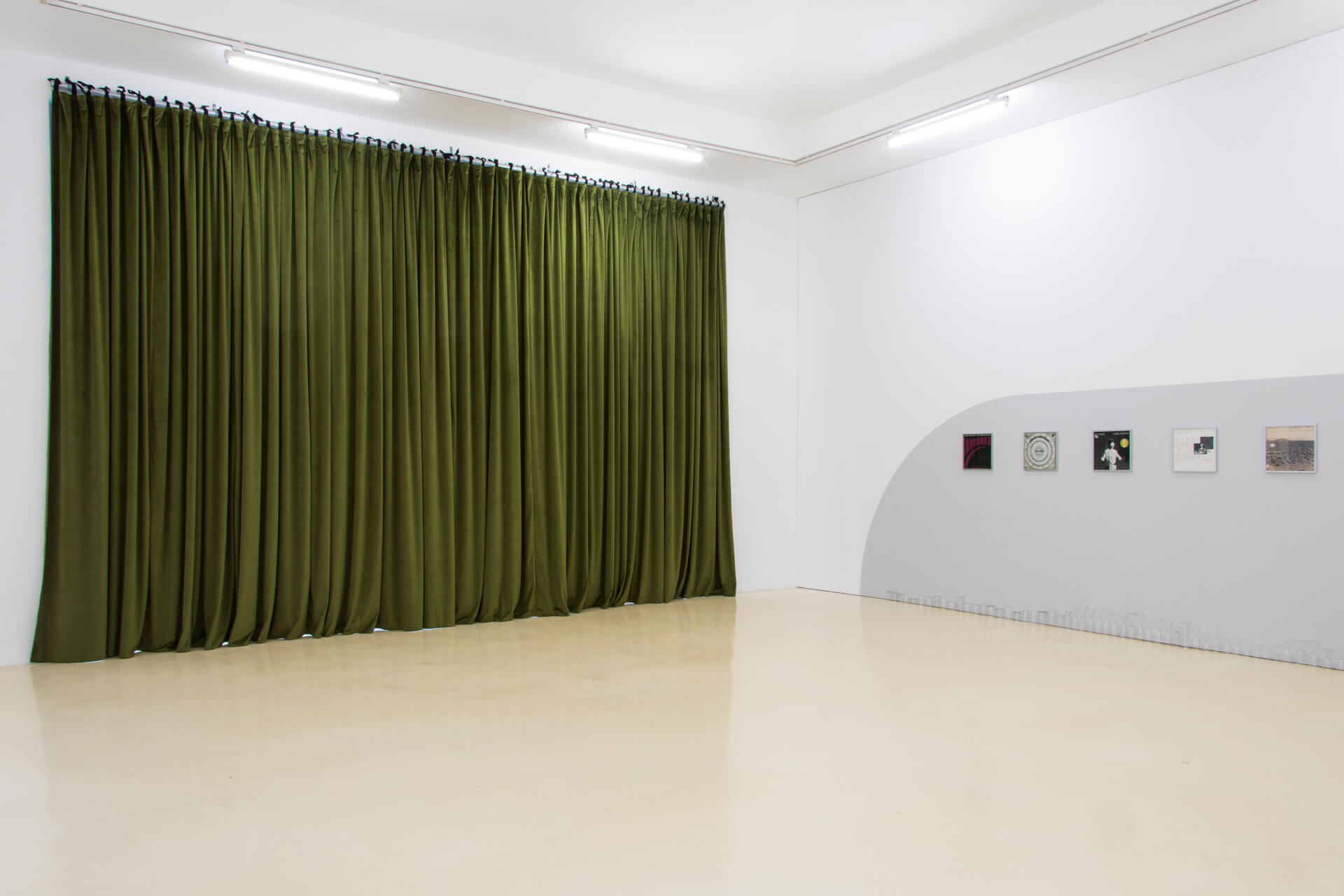
LP editions from the collection of the AdA – Archiv der Avantgarden, Dresden; Multiple titles; Multiple publishers; Gallery installation with wall painting, green curtain, and a collection of different glasses. © João Ferro Martins
We climb the stairs to the left here and then we reach this room which has 20 of the 23 records that are scattered around the exhibition. In the rooms downstairs you can see two records; here a third in this corridor; and there are 20 more – so I think it’s 23 in all. These records come from a suggestion Tobi made to me to engage with the Dresden avant-garde archive AdA . The archive is extremely vast; it has a lot of materials, posters, correspondence, photographs, etc. and also records and other objects. It’s not so much an archive of artworks as of objects surrounding the avant-garde art scene. And I very quickly went straight to the records, because [the record] is an item that I work with a lot – I work a lot with records and particularly the circular vinyl object. And I selected from a group of about five hundred works, five hundred and something… I couldn’t see the images on the covers, so I selected by titles, and I chose titles of works and artists that I empathise with in some way and which I could relate to this exhibition. Sometimes they’re cosmic things, sometimes they’re albums that discuss music itself conceptually and aspects of music for their music’s sake, sometimes they’re titles that can promote a certain humour, as here in the case of Cheap Imitation [1977] [by John Cage], which I put next to my imitation of a record player made in 3D [Pioneer PL-100, 2020].
Then it was really nice to realise that, although I chose the records blindly, when I started looking at the covers, I saw that almost all of them were beautiful.
Participant 1: But did the records come from Dresden?
JFM: The records came from Dresden, yes.
Participant 1: They could’ve come from my house…
JFM: We’ll have to make an exhibition with yours… [laughter] What we ended up working on here, in this room that I did together with Tobi, was to marry necessity with aesthetics. There were the criteria for the records not to be exposed to sunlight, while there was also the need for the room not to be too empty and the records not to get lost on the wall. They’re small, delicate objects and we also wanted to work out how the room was going to absorb these objects. And after Tobi suggested to create a wall painting, I chose this collection of glasses – a sort of sculptural-melodic phrase which provides a neat finish at the base of the wall, so as to make the whole room one object and not leave the elements too scattered.
TM: The glass is a recurring feature in your work. Can you talk a bit more about that? It appears in Conjugal composition – Coda, with the piano, in 2013, also [in the series] Compendium , and then as a single object in the work 90 Women (2014). Here, I think a lot of people might associate it with the sound it makes when you strike the edge of the glass, but maybe you could talk a bit more about that?
JFM: Yesterday I did a little tour with some friends and someone immediately said “Ah, this is a sound wave! It’s a wave”, and it had a bit to do with that too, but also with the aesthetic quality of each of those glasses… Any three-dimensional object has a musicality, we can say that all objects have a musicality, that a chair has a musicality…
TM: And it does. When we did the second Expanding Concert here with Mattin on 21 October 2020, those very chairs were used as an instrument in here and when they scrape across the floor, they make a noise.
JFM: But I also talk about musicality in the line of the object itself. We can almost say that the styling has a musicality and certain design objects have a musicality, a squarer object has a musicality, and a sinuous object has another musicality. And in that way, it’s also a compendium of visual musicalities on that difference – the difference between each glass, or between the glasses at the beginning and those at the end. No wonder that certain more delicate cocktails have a certain type of glass and then, for example, a vodka is drunk in a very simple glass. But this glasses thing comes from various places. This thing for example from Robert Wyatt, these songs about drunkenness. And, in the case of the piano, there was a joke about Boris Vian’s pianocktail. So much so that the pedals on that piano are mousetraps, and there is always this reference to mice in Boris Vian’s Froth on the Daydream. So, there was a playfulness with the book at that juncture. But then I was creating a relationship with this object. At this point, it’s no longer so much a conceptual question, but an aesthetic one: it’s an object with which I have already connected in such a way that it only has to do with the presence of the object itself, it has nothing to do with any kind of symbology or narrative.
TM: Another object that recurs frequently is the ball.
JFM: Circles and balls, yes.
TM: …which also appear in Compendium #2, 2010, with a glass ball, tennis ball, ping-pong ball.
JFM: And then a nut.
TM: …and a nut, a walnut. And here in the installation, below, these little balls also re-emerge as elements of play or as a substitute for something else.
JFM: This comes from various places – the circle, and consequently the sphere, are shapes I’ve always worked on – and it’s present here in these speakers [Mute Speakers, 2020]; a lot of my work with vinyl departs from the circle… This began with a pictorial exploration I did while still at university, which had to do with Delaunay’s work. After getting into that aesthetic game of Delaunay’s I was fascinated by the circle, the interrupted circle, the semicircle. I was extremely interested in the interrupted dynamic – a half-circle is almost like something that will turn and then stop! It’s dynamic/anti-dynamic and this half-dynamic, half-static thing – because a half-circle can only rotate halfway and then it will stop. And I started to work a lot on this shape because it’s a very complete shape, it’s the shape of movement, it’s the shape of the planets. The pebbles on the beach get rounded, they get filed, filed, filed down, and it’s almost as if the last stage is to become perfect spheres, from all the rolling around and… so it’s about that. And when I do that little dumping of objects down there, it has to do with an idea, also cosmic, of creating a kind of microcosm, a kind of zoom out to the universe, or a small universe, almost as if we could see that little corner as a small Milky Way, a zone, a galactic, spacial thing. But above all it has to do with the dynamism of the form. The circle is almost as important symbolically as fire. When he discovers fire, Man begins to cook and to have a more comfortable life; and when you find the circle, when you discover the circle, when you perceive the circle-form, there’s a kind of huge evolutionary kick-start, because it’s the form of dynamism, of dynamics, it’s the form of the fast forward. [laughter]
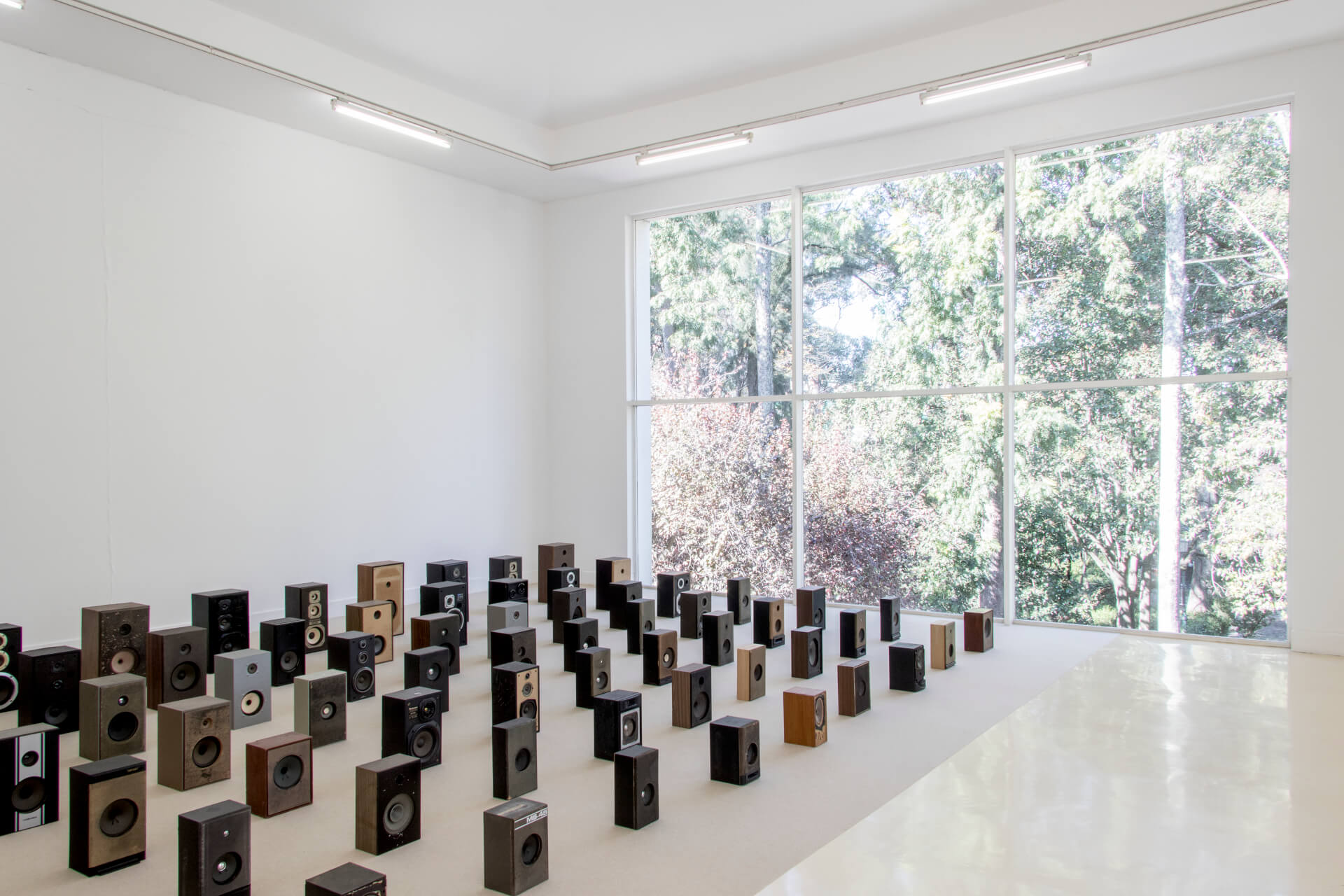
João Ferro Martins; Mute Speakers; 2020; 77 loudspeakers; Variable dimensions. © João Ferro Martins
TM: One last point I wanted to raise, before I open it up to the audience as well, is this even more sculptural moment in your work. Someone told me at the opening that they look like the headstones in a cemetery. Like headstones, they also refer to a mute aspect. And they are indeed mute, for all the speakers you’ve found have been abandoned, or appropriated, in short taken out of circulation. It’s a moment of frustration that also permeates the exhibition: the speakers don’t play, and the record player is also just a plastic replica.
JFM: Downstairs, the little auditorium is broken…
TM: Yes, the Moog is also just a non-functional model. And that too is a recurring theme. What interests you in this stance, in your approach of presenting the objects, the sculptures, in this way?
JFM: It was something that happened naturally. In fact, this began, or rather it’s more visible for the first time, in some very early works like, for example, the microphone that’s recording a stone, and you have the tape recording, and the microphone is waiting for a reaction from that stone, but that reaction will never come [Soundpiece #1, 2007]. In a later work, there’s a chair and a microphone and we can try to talk to the stone and try to get a reaction, but the stone will never respond [Soundpiece #3, 2009]. And then that became a recurring theme, the pure displacement… As I work a lot with everyday objects (I’m not exactly a sculptor, my work is more juxtaposition, assemblage, it’s not a case of modelling, it’s a work that involves selecting, configuring, and re-presenting), what ends up happening a lot, because they’re everyday objects, is that they lose their function, their everyday function, and become pure aesthetic enjoyment; they’re simply displaced. It’s an attitude that, in essence, has to do with the ready-made logic – the displacement of the everyday object to the gallery imbues the object with new codes and new ways of being seen.
TM: In that sense, you separate your more performative work in theatre or in a band – where things are more dynamic, or alive, or relational – from the visual artist work, which is more planted in the sculptural realm, which is more static, which is not so much in motion.
JFM: Yes, the dynamics are very different. In the work involving visual arts and sculpture the dynamic is very different from the work done with music and performance, because the final work in performance and in music is happening at the moment that it’s being produced. Obviously, there are rehearsals and preparations, but the moment of presentation is the moment of execution as well. In the visual arts it doesn’t work quite like that; the moment of presentation is already a post-production moment. Exploring all these areas, what ends up happening is that the visual arts are always the place where all these influences converge in order to appear. So, music, performance, theatre, all the things that I do externally, and for which I had no academic training (because I only had academic training for the visual arts, in all the other areas I’m an experimentalist, a self-taught person), all of it will then influence the visual arts – that external experience. But my relationship with people who work in the music medium, and in the theatre and performance medium, their interest in working with me is also because I’m a visual artist and I also take it there, so it’s a contamination. But it’s true that the visual arts really are dominated by a slightly different way of thinking, working and functioning compared with music and the performing arts.
TM: Perhaps you still have some comments, questions you would like to raise, observations. You already mentioned the records, do they look “avant-garde” to you, the covers?
Participant 1: Ah yes, yes, they look like a very good choice.
Participant 2: I searched the Internet, because I thought – because of Eloise, of the storm – of a pioneering woman in the electronic arts whose name was Éliane Radigue…
JFM: Éliane Radigue, yes. Yes, there were many, using that very Moog. In fact, perhaps more women than men. There was a lot of pioneering work in electronics being done by women.
Participant 2: There’s no Éliane and Eloise room…
JFM: Éliane and Eloise, that’s a possibility… [laughter] And indeed much of the most interesting work done at that time was done by women. Likewise, for example, the theremin, which is an extremely high-tech object, which was very much embraced by women, more so than by men. It’s not quite clear why, but it was a female appropriation, and it’s very funny. It’s also a very delicate object, it has a way of playing that’s extremely choreographic… and it was invented by Theremin, of course.
TM: Regarding the turntable, João, the question came up in conversation as to whether it was painted or if it comes out of the 3D printer that colour. Could you talk a bit more about your suggestion to choose this plinth, which suggests a colour, a warmer temperature versus that print, which is more “arctic”?
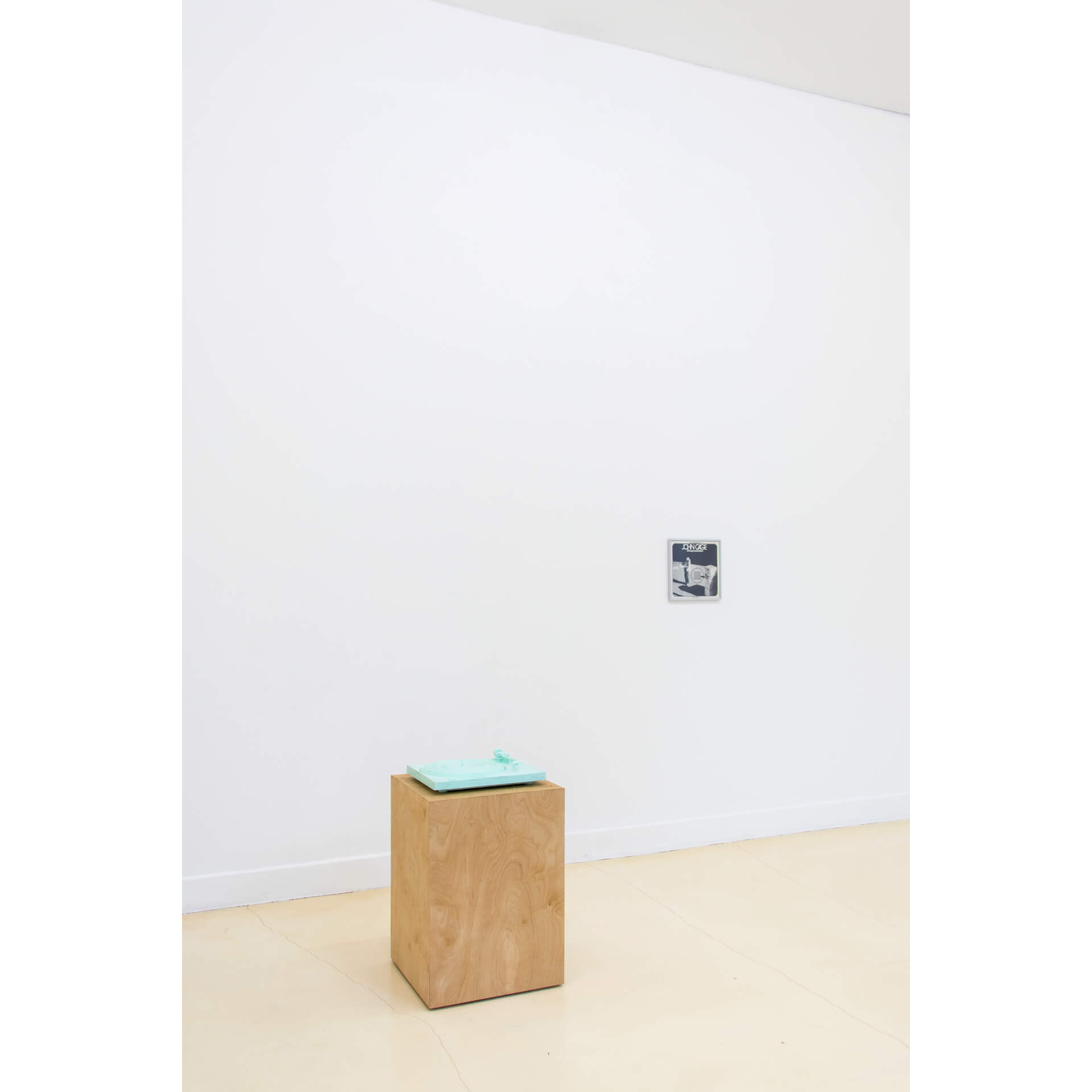
João Ferro Martins; Pioneer PL-100; 3D print and wooden plinth; 2020 | John Cage; Cheap Imitation (1969); LP Edition, Nova Musicha, No. 17; 1977; Collection of the AdA – Archiv der Avantgarden, Dresden. © João Ferro Martins
JFM: I chose to make this 3D print as a game, a joke. I’d been making models in bronze and yet bronze had begun to bore me. It’s a very classic thing, it’s incredibly dazzling, bronze is very beautiful, but it started to be a little rhetorical for me to make objects in bronze, to dignify the object – you turn the glass to bronze and it becomes “Wow!”… And suddenly I thought: what would be the 21st-century material for making moulds, for making a replica? And 3D occurred to me. It’s very “Anthropocene”, it’s very much the material of the 21st century – melted plastic to make a copy. What we see there is the original colour of the plastic, which you can choose. You can choose the plastic thread that you put in the machine and I chose that colour specifically. But, in essence, it’s an exact replica of the original object, in plastic. And again, replicating what happens downstairs [in the installation Studio Eloise, 2020] with the marble plinths and a plastic chair, I wanted to invert the materials’ codes. Therefore, the plinth is the one that’s made from a worthy and noble material, and the object that is being exhibited is virtually rubbish, it’s plastic, it’s old. And here it was an attempt to also work on that notion I have down there, in which the plinth is more luxurious than the object itself, and create this displacement, also aesthetic in a way, of this code we normally have that the plinth doesn’t exist, it’s not there to be seen, and only serves to dignify the object. But in this case, the plinth is almost more visually appealing than the object itself. The object, being such a fluorescent green, attempts to combat that. And downstairs the same thing happens: we only pay more attention to the chair because it’s on top, but then you start to realise that those marble plinths, those marble feet, really create a dissonance with the plastic object, which is not very luxurious.
TM: Downstairs, you also chose a plinth that’s more closely associated with the entertainment industry.
JFM: Yes, it’s a box that they call a crate, for transporting sound material, when there are touring concerts, to transport the material, and I used it as a plinth, to support a cement replica of a loudspeaker.
TM: Looking at the installation downstairs, I keep thinking also of Fischli & Weiss and Der Lauf der Dinge [“The Way Things Go”] [1987], where one thing touches another thing that then sets it in motion. It’s like a frozen still of that.
JFM: Yes. Eternally Collapsing Objects… When you get to the exhibition and read the title, you immediately look at the fallen chairs, and it feels like I’m making a literal joke, “Ah, the object is actually collapsing”. Obviously, it’s not about the chairs being down. But yes, that is the way things go […] in this exhibition, isn’t it? [laughter] What’s most important to me is that my work communicates with people’s everyday life, it’s important to me that people recognise the objects. I don’t really create an abstract language, or a deformed or formless object that people don’t recognise. My game is more ‘pulling the rug out’, using things that people know, but turning them upside down, that alone. What is there to say? It’s a “Duchampian” thing, that’s all… But what I think is that that legacy leaves much to be explored, it’s not a legacy… it’s not a river that has dried up for me. Although my work very much has that aspect of a work already out of time… seventies… [laughter] But okay, I can also be a curator of my own work, a kind of curator of a timeless work. I have a notion that I do “old fashioned” work, but then the languages and the narratives are narratives that are current and relate to the present day. I think that, in fact, research fields like Fluxus and Dadaism aren’t sources that have run dry, I think there are still things to be said about them. It’s not that I think I’m a representative of those waves, but I understand that there are aesthetic connections to those waves, just as oil painting continues to be done. People still do oil paintings, and it’s very “archaic”, isn’t it? [laughter]
TM: And so, would you say that your work has a certain nostalgia?
JFM: I think it opens that discussion – it’s a long-running discussion, many artists talk about this – that artists are always after their childhood, they’re always trying to recover their childhood and that there are constant recurrences of childhood themes. And I think my attraction to a set of objects, in the case of these speakers here, for example, these are objects from my childhood. I don’t relate, perhaps, to a more modern speaker, I can only relate to these, which are precisely from my childhood days. I think there’s a constant return to the aesthetics of when we were younger. I think when we’re young we create our aesthetic substance and then we spend the rest of our lives working around that. [laughter] I think it’s when we’re young that we create the framework that we’re going to have from then on, which gets more and more intellectualised, but the aesthetic foundations…
TM: The core…
JFM: The core I think comes from many things… This thing of me using balls, this recalling of tennis balls, for example, that I have a lot in my work, using a tennis ball: there was a tennis court at my house… I think they’re always references to childhood memories, and we always want to be close to those objects, or those references, because they’re ‘micro-elixirs’, they’re ‘elixirs’. And I think all artists… It’s hard for an artist to say that they don’t always draw on or don’t heavily draw on the imagery of childhood.

